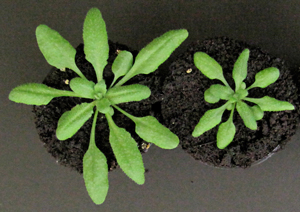Jan. 24, 2014 Research Highlight Biology
Many ways to grow
Plant hormones with signaling pathways that seemingly overlap play distinct roles in controlling growth
 Figure 1: Compared to a normal plant (left), thale cress plants lacking the capacity to produce the cytokinin tZ (right) exhibit poor shoot growth and smaller rings of leaves. © 2014 Hitoshi Sakakibara, RIKEN Center for Sustainable Resource Science
Figure 1: Compared to a normal plant (left), thale cress plants lacking the capacity to produce the cytokinin tZ (right) exhibit poor shoot growth and smaller rings of leaves. © 2014 Hitoshi Sakakibara, RIKEN Center for Sustainable Resource Science
Cytokinins are plant hormones that help to coordinate plant growth and development in response to different environmental triggers. They primarily differ from one another in their ‘side-chains’ — chemical modifications that are tacked on by specialized enzymes. Research from Hitoshi Sakakibara and co-workers at the RIKEN Center for Sustainable Resource Science now demonstrates clear differences in the functions of these various hormones1.
The thale cress plant, Arabidopsis thaliana, makes heavy use of two particular cytokinins, N6-(Δ2-isopentenyl)adenine (iP) and trans-zeatin (tZ), which act on the same three receptor proteins. This raises the question of whether they have meaningfully different effects on plant growth. “Although there is this side-chain diversity in natural cytokinins, it has been an open question whether or not the diversity is biologically relevant,” explains Takatoshi Kiba, a research scientist in Sakakibara’s group.
To resolve this question, the researchers generated genetically modified plants that lacked the capacity to manufacture tZ. The cytokinin tZ is produced from a precursor of iP, which undergoes processing by the cytochrome P450 monooxygenase enzyme CYP735A. Accordingly, plants lacking CYP735A showed dramatically reduced tZ levels, with a compensatory increase in iP production. The absence of CYP735A also had a striking effect on growth, resulting in stunted shoots crowned with narrower rings of leaves (Fig. 1). Spraying with tZ restored normal shoot growth to the mutant plants, whereas treatment with iP did not. Interestingly, tZ appeared to play a minimal role in root development, although the hormone can be produced in plant roots and trafficked throughout the plant.
Kiba and his colleagues subsequently generated tZ-deficient plant strains that also lacked various subsets of the three cytokinin receptors. Two of these receptors bind to both iP and tZ equally well, and the researchers anticipated that further deficits in shoot growth might be mitigated in plants retaining either of these receptors due to the elevated iP levels. Instead, the growth defects were even more pronounced than in plants lacking tZ alone, demonstrating that the cytokinins are not interchangeable.
The results suggest that a selective boost in tZ cytokinin activity could be a winning strategy for crop improvement. “Increasing the proportion of tZ by overexpressing CYP735A results in shoot-growth enhancement without reducing root growth,” says Kiba. In future work, the Sakakibara lab will delve deeper into the mechanisms that allow plant cells to differentiate tZ and iP signals, as well as the systems that help to shuttle the hormones throughout the plant.
References
- 1. Kiba, T., Takei, K., Kojima, M. & Sakakibara, H. Side-chain modification of cytokinins controls shoot growth in Arabidopsis. Developmental Cell 27, 452–461 (2013). doi: 10.1016/j.devcel.2013.10.004
